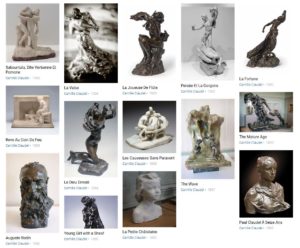Camille Claudel was born in France. Her early education was a traditional Catholic education. As she grew older, she became interested in an artistic future. She began to sculpt the human form in clay. Her mother was aghast. Her father was more supportive.
Her father arranged to have an artist neighbor become her mentor. She trained with him for three years before he moved to Italy. Before her mentor left, he arranged for Camille to work with another sculptor.
Camille’s relationship with her second mentor grew from mentor-protégé to a romantic connection. Her family was not happy and forced her to leave home. When she ended a pregnancy, the relationship became less intimate but continued.
She was ostracized by the artist community and led a beggar’s existence. She was forced to reconnect with her second mentor. Many of his works were inspired by Camille, but she received no credit.
Her own work began to reach artistic levels that rivaled her second mentor. She began to develop her own style leading to a jealous breakup with him. She was no longer his obedient follower. He went so far as to take credit for some of her works.
She was unable to get commissions because of her unsavory relationship with a noted sculptor. Also, her artistic style had begun to diverge from the more traditional tastes in sculpture.
Camille began to show signs of mental illness, and she destroyed many of her works. She was admitted to an asylum where she spent the last 30 years of her life.
Camille Claudel is little known today. Her mentor/lover, Auguste Rodin, is one of the most famous sculptors, especially for his sculpture, The Thinker.
Just imagine how many creative women faced similar situations. We often believe in myths such as women aren’t creative. In fact, women have had a history of creative work that has often been suppressed by gender politics of the time and by men taking credit for their work. Today Camille’s sculptures are on display in most major museums around the world. Ironically, the Musée Rodin in Paris has a room focused on her works.
* * *
